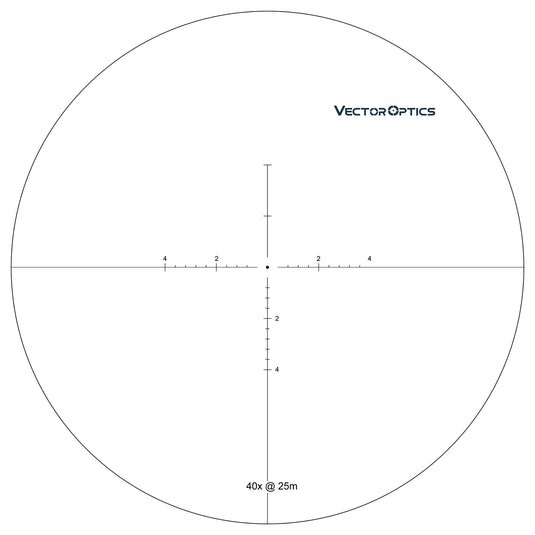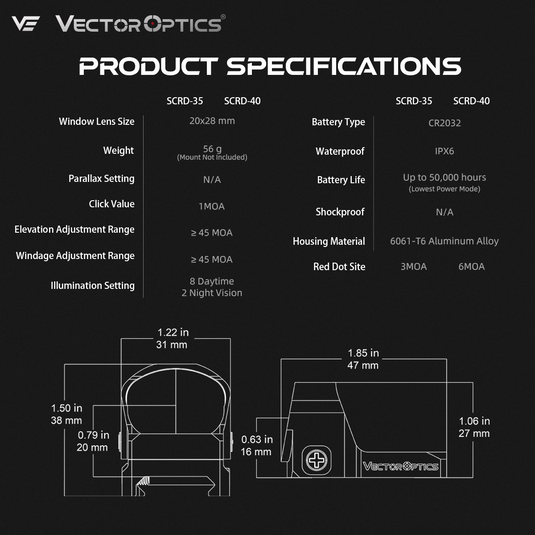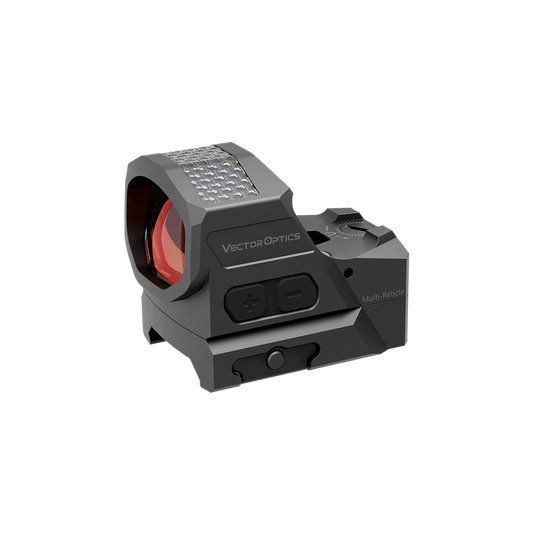LPVO has been trending in recent years. What does that mean? Whether you need it or not? What things to consider when picking a satisfied LPVO? To keep it short, LPVO, the acronym of Low Power Variable Optics, provides the versatility of allowing quick target acquisition at close ranges, like a red dot, and improving precise aiming at long distances. In this article, I will compare our Continental x6 1-6x24 LPVO Tactical (SCOC-23T) and Hunting (SCOC-23) ones to guide you find the one fitting for your specific need.
Capped turrets vs Exposed turrets
The notable difference between hunting (SCOC-23) and tactical (SCOC-T23) scopes is the turret. Tactical scopes usually have exposed (pop-up) turrets for quick adjustment during the competition, while hunting scopes have capped turrets for preventing slippage when hunters track the targets in the bush. With the cap, the scopes are more durable than the exposed ones. The only sacrifice is the adjustment. Therefore, hunting scopes are more suitable for fixed-range shooting. The tactical scopes with exposed turrets provide more convenience for adjustment during the competition.

MOA VS MIL
Another distinction is the unit of measurement, tactical scopes utilizing MIL (milliradian) /MRAD and hunting ones implementing MOA (Minute of Angle). Although this is a common pattern, it's not an absolute rule. There is always a debating topic, which unit is the better. No conclusion. It depends on your personal calculation system and preference. Indeed, if you grew up in the United States or are accustomed to the imperial system, MOA may be more user-friendly than MIL. MIL is intuitive for those familiar with the metric system (meter, centimeter). 1/10 MIL equals to 1 centimeter at 100 meters.
Specifically, MOA corresponds to 1.047 inches at 100 yards. Mil equals to 3.6 inches at 100 yards. These two units are both angular measurements. They could be converted to each other, 1 MIL equaling 3.438MOA. Indeed, there are subtle differences, if you want to say so. MOA is finer than MIL. In other words, it is slightly more precise than MIL. However, if the target is large, preciseness is not super important, MIL provides convenience for adjustment. Shooters would take less time to adjust. Usually, tactical one using MIL and hunting one using MOA.

Duplex Reticles VS Ballistic Reticle
Reticle designs are the third character distinguishing tactical (SCOC-T23) and hunting (SCOC-23) scopes. Our hunting ones implement German#4 reticle with an illuminated center dot. German #4 is like a duplex variant, allowing a clear field of view at the top half of the reticle without a bold line, simultaneously directing shooters’ attention to the center with three bold lines on the left, right and bottom. The center dot serves as the aiming point, particularly valuable for shooting small targets or at extended ranges. Furthermore, the illumination feature enhances visibility at low-light conditions for easy target acquisition and accurate aiming.
Tactical scopes, on the other hand, incorporate complex BDC reticles for ballistic compensation and range finding. The VET-BTR reticle features an illuminated center dot surrounded by a horseshoe-shaped ring, incorporating both bullet drop compensation (BDC) as well as wind drift compensation. This means shooters can achieve rapid and precise shots without relying on a separate rangefinder or ballistic calculator. Additionally, the reference points on the horizontal lines enable quick estimation of wind speed and direction, facilitating swift windage adjustment.
If you would love to learn more about the reticles, check BDC VET-BTR Manual and German #4 Manual.
https://www.vectoroptics.com/data/uploads/2023/08/23/1692777142.pdf https://www.vectoroptics.com/data/uploads/2023/06/19/1687163114.pdf

SFP VS FFP
These two Continental LPVOs are both SFP (Second Focal Plane), which features a consistent reticle size regardless of magnification changes. The reticle would stay visible no matter how you zoom in and out. This feature allows hunters to observe target details clearly and determine bullet strike points precisely. The downside of SFP is that shooters can only estimate the distance under certain magnification. SFP is relatively popular for hunting or close-range shooting.
However, it is common to see some tactical scopes implement FFP, of which the reticle would change along the changing of magnification. It is quite intuitive and user-friendly for long-range shooting. Shooters could estimate the distance under any magnification. However, there are some tricky trade-offs. The reticle at low magnification might be unclear under the low light condition. Also, it is more costly than SFP. If you are interested in FFP LPVOs, we also provide several options, 34mm Continental x6 1-6x28 FFP Riflescope (SCFF-31), Continental x10 1-10x28 ED FFP Riflescope (SCFF-47 & SCFF-48).

To sum, LPVO provides the advantages of magnification and precision for long distance shooting, and true 1x power for quick target acquisition. Now, it should be easier for you than before to pick the Continental LPVOs based on your personal shooting purpose and habits. A quick review below about the differences between tactical and hunting scopes.

Lastly, we also provide a FDE color option, Continental x6 1-6x24 Tactical LPVO FDE SCOC-34.


































